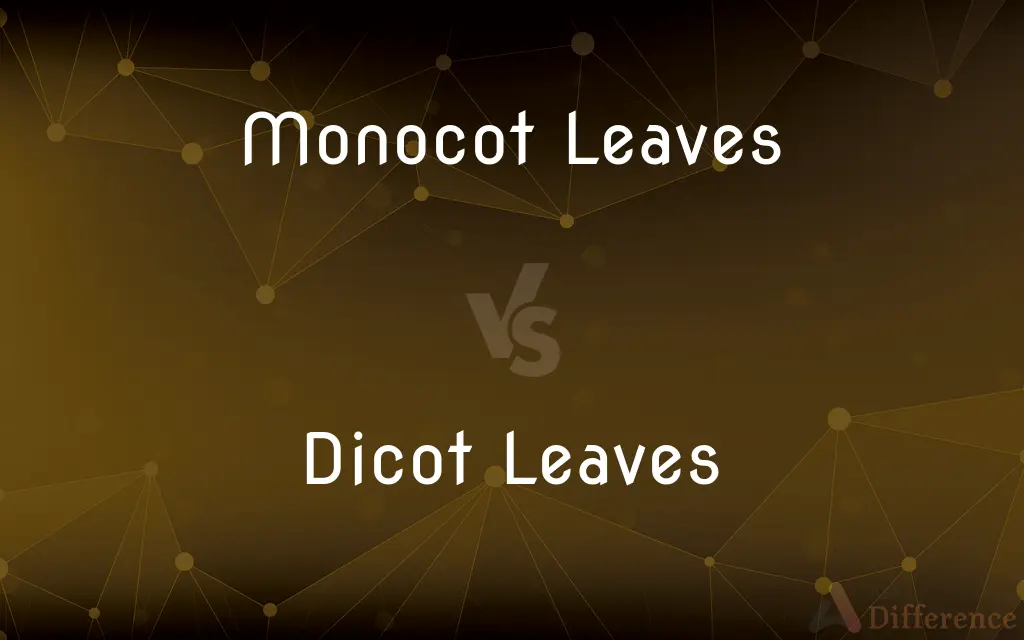Monocot Leaves vs. Dicot Leaves — What's the Difference?
Edited by Tayyaba Rehman — By Fiza Rafique — Published on January 12, 2024
Monocot leaves have parallel veins and a slender shape, while dicot leaves feature a branched vein pattern and a wide variety of shapes.

Difference Between Monocot Leaves and Dicot Leaves
Table of Contents
ADVERTISEMENT
Key Differences
Monocot leaves are typically characterized by their parallel vein structure. This refers to the arrangement of the vascular system within the leaf, where veins run side by side from the base to the tip. Conversely, dicot leaves usually have a network of veins that form a more complex branching pattern known as reticulate venation. This difference in venation is one of the most distinguishing features when comparing monocot and dicot leaves.
In the structure of monocot leaves, they often have a long, narrow shape and may be attached to the plant without a distinct petiole. In contrast, dicot leaves come in a wide range of shapes including broad, oval, or heart-shaped forms, and they commonly have a petiole that connects the leaf blade to the stem. The variety in shape and attachment reflects the diverse adaptations of dicot leaves to their environments.
Monocot leaves are part of plants that are classified as monocots, which are one of the two major groups of flowering plants. This group includes grasses, lilies, and palms. Dicot leaves belong to dicotyledonous plants, encompassing a vast array of species including roses, peas, and oak trees. The terms themselves originate from the number of cotyledons, or seed leaves, present in the plant's embryo—monocots have one, while dicots have two.
The arrangement of stomata, which are the pores used for gas exchange, also tends to differ between monocot and dicot leaves. Monocot leaves usually have stomata on both sides, displaying an isobilateral structure, whereas dicot leaves often have the majority of their stomata on the underside, which is known as a dorsiventral structure.
Lastly, the growth pattern of monocot leaves often involves the base of the leaf wrapping around the stem, which is not typically seen in dicot leaves. Dicot leaves usually grow outwards and are connected to the stem via a node. This reflects the differences in growth habits and stem structure between monocot and dicot plants.
ADVERTISEMENT
Comparison Chart
Vein Pattern
Parallel veins
Branched veins
Shape
Typically long and narrow
Wide variety of shapes
Petiole Presence
Usually absent
Usually present
Stomatal Arrangement
Isobilateral
Dorsiventral
Cotyledons in Seedling
One
Two
Compare with Definitions
Monocot Leaves
A component of grasses and lilies, among other monocots.
The lily's monocot leaves were bright green, stretching out towards the sunlight.
Dicot Leaves
Often broad leaves with a network of branched veins.
The maple's dicot leaves turned a fiery red, the branched veins like highways on a colorful map.
Monocot Leaves
Leaves with equal numbers of stomata on both sides.
The cornfield was a sea of monocot leaves, each with stomata on their upper and lower surfaces.
Dicot Leaves
Leaves from plants with two embryonic seed leaves, or cotyledons.
The bean plant unfurled its dicot leaves, revealing the delicate branching of its veins.
Monocot Leaves
Leaves from plants with a single embryonic seed leaf, or cotyledon.
The lawn was a carpet of monocot leaves, all showing their characteristic parallel veins.
Dicot Leaves
Part of dicotyledonous plants, usually with a distinct petiole.
The rose's dicot leaves swayed on their petioles, covered in morning dew.
Monocot Leaves
Narrow, elongated leaves with veins that run parallel from base to tip.
Monocot leaves rustled in the wind, their parallel lines like nature's barcode.
Dicot Leaves
A characteristic of a wide range of plants including oaks and sunflowers.
Sunflowers towered overhead, their dicot leaves capturing the sun's rays to fuel their growth.
Monocot Leaves
A part of monocotyledonous plants, typically lacking a petiole.
In the tropical garden, the palm tree displayed its monocot leaves proudly against the sky.
Dicot Leaves
Leaves typically with more stomata on their underside.
The tomato plant's dicot leaves had a concentration of stomata on their lower surface, hidden from sight.
Common Curiosities
What is a dicot leaf?
A dicot leaf originates from a dicotyledon plant and usually features a branched vein pattern.
How can I tell a monocot leaf from a dicot leaf?
Look at the vein pattern—parallel in monocots, branched in dicots.
What are the shapes of dicot leaves?
Dicot leaves vary widely in shape, from broad and rounded to narrow and pointed.
How many cotyledons do monocot leaves' plants have?
Monocot plants have one cotyledon in their seeds.
Are there any monocot plants with dicot-like leaves?
No, monocot leaves are consistent with their parallel vein pattern.
Do all monocot leaves look the same?
While they share similarities, such as parallel veins, their sizes and exact shapes can vary.
Why do monocot leaves have a different vein pattern?
It's a result of their evolutionary pathway and the structure of the plant.
How many cotyledons do dicot leaves' plants have?
Dicot plants have two cotyledons in their seeds.
What is a monocot leaf?
A monocot leaf comes from a monocotyledon plant and typically has parallel veins.
Do monocot leaves have petioles?
Monocot leaves often do not have petioles; they connect directly to the stem.
Can dicot leaves have parallel veins?
It's rare; dicot leaves typically have a network of branched veins.
What types of plants have monocot leaves?
Grasses, lilies, and palms are common plants with monocot leaves.
Which plants feature dicot leaves?
Roses, peas, oak trees, and most flowering plants have dicot leaves.
Are the stomata on monocot leaves different from those on dicot leaves?
Yes, monocot leaves typically have stomata on both sides, while dicot leaves usually have them on the underside.
Are dicot leaves more common than monocot leaves?
Both types are common, but dicots encompass a greater variety of plants.
Share Your Discovery

Previous Comparison
Masons vs. Freemasons
Next Comparison
McAfee vs. KasperskyAuthor Spotlight
Written by
Fiza RafiqueFiza Rafique is a skilled content writer at AskDifference.com, where she meticulously refines and enhances written pieces. Drawing from her vast editorial expertise, Fiza ensures clarity, accuracy, and precision in every article. Passionate about language, she continually seeks to elevate the quality of content for readers worldwide.
Edited by
Tayyaba RehmanTayyaba Rehman is a distinguished writer, currently serving as a primary contributor to askdifference.com. As a researcher in semantics and etymology, Tayyaba's passion for the complexity of languages and their distinctions has found a perfect home on the platform. Tayyaba delves into the intricacies of language, distinguishing between commonly confused words and phrases, thereby providing clarity for readers worldwide.
















































